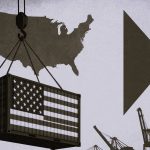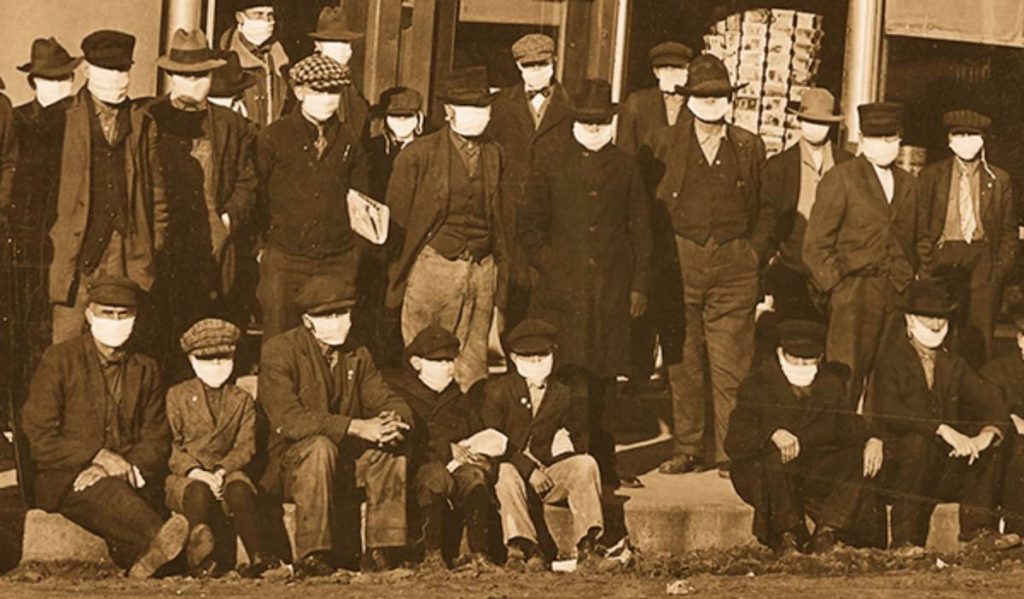
A Dark Sense of Humor

In this haunting photo, a man in Australia poses with a painted skull-and-crossbones on his mask.
Straining the Medical System

Military pathologists believe that a British outpost in Étaples, France was the epicenter of the outbreak. In the winter of 1916-17, with World War I still raging in Europe, reports of a new disease — one with a rapid onset and high spreadability — circled through the camp. When soldiers returned from the battlefields, they brought that disease with them.
Eventually, hospitals were so overcrowded that overflow facilities, like this one at the Eberts Field military base in Arkansas, were created.
Baseball during a Pandemic

During the 1918 flu pandemic, baseball players, umpires and fans donned masks and headed to the diamond.
“Better Be Ridiculous Than Dead”

During the 1918 pandemic, the New York Health Board’s stance regarding wearing masks was: “Better be ridiculous than dead.”
A misnomer and wartime morale

In nations involved in World War I, government censors prevented local newspapers from reporting on outbreaks.
Spain remained neutral, though, and their press reported freely.
That censorship — in countries like Britain, France, Germany and the United States — led to the misconception that Spain was the origin of the virus. The Spanish flu name stuck.
Social distancing ordered

In St. Louis, Missouri, shortly after the first cases of flu were detected, local health officials ordered schools, churches, courtrooms and libraries closed. Gatherings of more than 20 people were banned. This limited the number flu deaths in the city.
Philadelphia parade

But not every city was as vigilant. There’s not a mask in sight in this photo of a 1918 Memorial Day parade in Philadelphia. The death toll ended up being much higher there than in cities with stricter lockdowns.
The 1918 flu killed 675,000 Americans. “That’s equivalent to 225 to 450 million people today,” said John Barry, a scholar at Tulane University and author of “The Great Influenza.” “The numbers are staggering.”
Familiar headlines

Many of the headlines on the front page of the Seattle Daily Times from October 5, 1918, look a lot like the headlines from spring 2020.
Camphor necklaces

Some people believed that a bag of camphor around the neck could prevent the rapidly spreading flu.
An unusual mask

In February 1919, a woman wore this flu mask connected to two machines with a long hose.
No mask, no ride

A Seattle streetcar conductor turned one commuter away because he wasn’t wearing a face mask.
Gargling at work

In addition to masks, many believed that gargling with warm salt water and mouthwash would stave off infection.
All rise

In San Francisco, court was held in a park in an attempt to curb the spread of the deadly flu.
No social distancing here

In San Francisco, the congregation of the Cathedral of Saint Mary of the Assumption gathered to hear Mass.
Windows open

Windows were kept open on public transportation lines to curb the spread of the virus. This trolley sign urges people to keep windows open at home as well.
School is in session

In 2020, many children are being homeschooled or receiving lessons online. But many schools remained open during the 1918 pandemic; like their grownup counterparts, children wore masks.
Disinfecting spray

Buses were sprayed with anti-flu disinfectants.
Fresh air as a treatment

At the influenza camp in Lawrence, Maine, patients were prescribed fresh air as a treatment.
Conductorettes

Streetcar conductors and conductorettes (as female drivers were known) all wore masks to prevent infection.
A glimmer of hope

In October 1918, Boston mayor Andrew Peters invited news crews to come along as he received a flu shot.
Though thousands of Bostonians followed the mayor’s lead, subsequent studies found no real evidence the vaccine had been effective.
Advocates in Paris

In Paris in 1919, two men wore flu masks and advocated for others do the same.
Gargling in the military

These men at Camp Dix in New Jersey gargle with saltwater after a day’s work at the camp.
Fresh air as a preventative measure

Each day, women from the Department of War gathered for a 15-minute morning walk, in the hopes that the fresh air would ward off the flu.
Boston’s finest
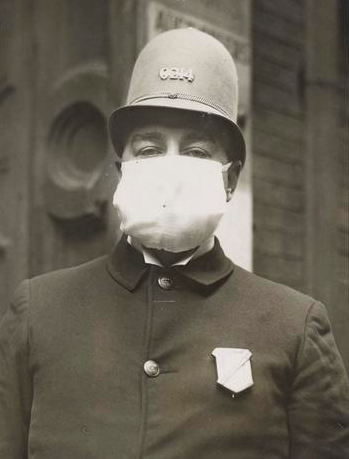
The Boston Police Department distributed 1,700 masks to their officers to wear when they were on duty.
Standing at attention

These Seattle policemen lined up in their gauze masks.
The show must go on

This hospital in Indiana had its own orchestra.
At the office

Before the internet, working remotely wasn’t an option. This typist wore a mask while working at her office desk in 1918.
Tough to stay motivated

This telephone operator wears a gauze mask while working.
Clerks at work

These New York City clerks sat in cramped quarters with their masks on.
Living up to the U.S. Postal Service creed

Just like today, mail delivery was an essential function during the 1918 flu.
Working hard

And the streets continued to be swept.

Here, a crossing guard is seen wearing a mask and gloves.
Nurses on the front lines

During any pandemic, nurses are on the front lines of the battle against disease.
Nurses were essential workers

Many people (mostly women) volunteered to join nursing groups to help battle the pandemic.
Making and distributing equipment

In 1919, these Red Cross nurses in Boston prepared bundles of masks to be distributed to soldiers. Meanwhile, other nurses were tasked with making the masks.
Mask making

This is what a Red Cross mask-making station looked liked in 1918.
Taking care of patients
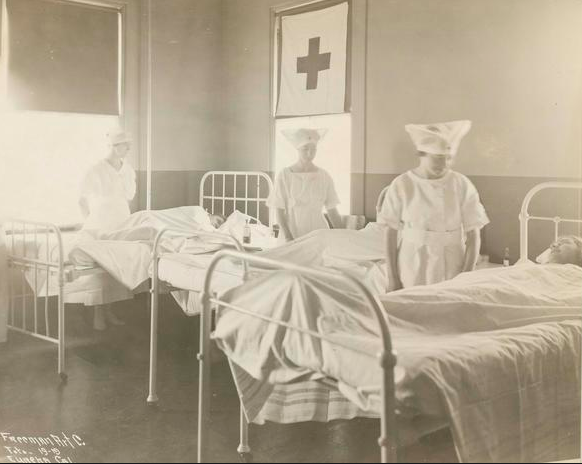
These volunteer nurses in Eureka, California tended to influenza patients at a Red Cross hospital in 1919.
Preventing cross-contamination

This nurse is seen sterilizing a hospital room at the War Influenza Camp in Lawrence, Massachusetts.
Volunteer workforce

The Red Cross assembled teams of volunteers to help fight the pandemic in the United States.
Across the Pacific

In Japan, these school girls wore their protective masks to guard against the influenza outbreak.
Crowds gathering from coast to coast

In October of 1918, months into the influenza outbreak, this crowd of war munitions workers in Washington D.C. gathered to drink hot chocolate near the Washington Monument.
Walter Reed Hospital flu ward

Meanwhile, 20 miles away at Walter Reed Hospital, influenza patients were put in beds on the porch, separated by hanging sheets.
Pandemic shopping attire

Women in New York City could be seen bundled in scarves and masks while out shopping.
The battle after the war

The 39th Regiment marched through Seattle on its way to a deployment in France during the pandemic. Each soldier was outfitted with a mask provided by the Red Cross.
Open-air hospital

This outdoor Army hospital was constructed to house sick soldiers.
Pumping the water

Here, a nurse pumps water at a makeshift influenza hospital.
Expanding hospital capacity

The U.S. Navy set up this emergency camp outside of Mare Island Naval Hospital in Northern California.
Inside the influenza ward

This is what it looked like inside the Mare Island influenza ward.
Navy soldiers working through the crisis

Workers at the Navy’s hospital at Fort Porter in New York wore masks while working.
Ranking officers

These officers were in charge of the War Influenza Camp in Lawrence, Massachusetts.
Nurses taking a break

These volunteer nurses gather for a photo on the porch of the hospital in Eureka, California.
Trouble multiplies

These female ambulance drivers help influenza patients injured in an explosion in New Jersey.
Wesleyan influenza hospital

Red Cross workers inspected equipment at an emergency hospital at Wesleyan University in Middletown, Connecticut.
The epidemic reaches New Orleans

Nurses provide treatment to an influenza patient in New Orleans in 1918.
Civic duty
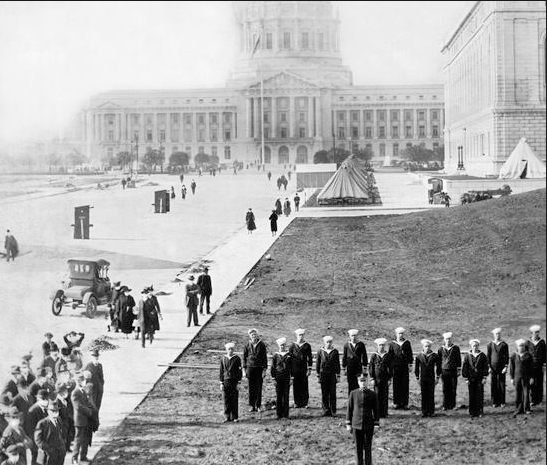
In 1918, San Francisco’s Civic Center complex served as an emergency Navy flu hospital.
Parade for the president

Here, President Woodrow Wilson (left) waves from a parade car after returning to the United States from France in 1918 at the end of World War I.
Public domain images published by CBS News, republished for educational, non-commercial purposes.


